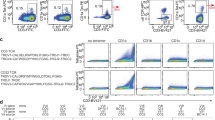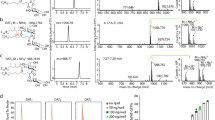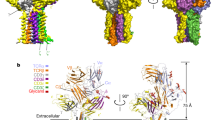Abstract
γδ T cells, especially Vγ9Vδ2 T cells, play an important role in mycobacterial infection. We have identified some Vγ9Vδ2 T cells that recognize protein/peptide antigens derived from mycobacteria, which may induce protective immune responses to mycobacterial infection. To clarify the structural basis of the molecular recognition mechanism, we tried many methods to express the Vγ9Vδ2 T-cell receptor (TCR). The Vγ9Vδ2 TCR was not expressed well in a prokaryotic expression system or a baculovirus expression system, even after extensive optimization. In a mammalian cell expression system, the Vγ9Vδ2 TCR was expressed in the form of a soluble heterodimer, which was suitable for crystal screening. Reduced-temperature cultivation (cold shock) increased the yield of the recombinant TCR. The recombinant purified TCR was used for crystal trials, and crystals that could be used for X-ray diffraction were obtained. Although we have not yet determined the crystal structure of the Vγ9Vδ2 TCR, we have established a procedure for Vγ9Vδ2 TCR expression and purification, which is useful for basic research and potentially for clinical application.






Similar content being viewed by others
References
Papadopoulou M, Sanchez Sanchez G, Vermijlen D (2020) Innate and adaptive gammadelta T cells: how, when, and why. Immunol Rev 298:99–116
Lee D, Rosenthal CJ, Penn NE, Dunn ZS, Zhou Y, Yang L (2022) Human gammadelta T cell subsets and their clinical applications for Cancer Immunotherapy, Cancers (Basel), 14
Chan KF, Duarte JDG, Ostrouska S, Behren A (2022) Gammadelta T cells in the Tumor Microenvironment-Interactions with other Immune cells. Front Immunol 13:894315
Wang X, Lin X, Zheng Z, Lu B, Wang J, Tan AH, Zhao M, Loh JT, Ng SW, Chen Q, Xiao F, Huang E, Ko KH, Huang Z, Li J, Kok KH, Lu G, Liu X, Lam KP, Liu W, Zhang Y, Yuen KY, Mak TW, Lu L (2021) Host-derived lipids orchestrate pulmonary gammadelta T cell response to provide early protection against influenza virus infection. Nat Commun 12:1914
Chen ZW (2013) Multifunctional immune responses of HMBPP-specific Vgamma2Vdelta2 T cells in M. tuberculosis and other infections. Cell Mol Immunol 10:58–64
Shen L, Huang D, Qaqish A, Frencher J, Yang R, Shen H, Chen ZW (2020) Fast-acting gammadelta T-cell subpopulation and protective immunity against infections. Immunol Rev 298:254–263
Spencer CT, Abate G, Blazevic A, Hoft DF (2008) Only a subset of phosphoantigen-responsive gamma9delta2 T cells mediate protective tuberculosis immunity. J Immunol 181:4471–4484
Cheng C, Wang B, Gao L, Liu J, Chen X, Huang H, Zhao Z (2018) Next generation sequencing reveals changes of the gammadelta T cell receptor repertoires in patients with pulmonary tuberculosis. Sci Rep 8:3956
Xi X, Han X, Li L, Zhao Z (2011) Gammadelta T cells response to Mycobacterium tuberculosis in pulmonary tuberculosis patients using preponderant complementary determinant region 3 sequence. Indian J Med Res 134:356–361
Xi X, Han X, Li L, Zhao Z (2013) Identification of a new tuberculosis antigen recognized by gammadelta T cell receptor. Clin Vaccine Immunol 20:530–539
Deseke M, Prinz I (2020) Ligand recognition by the gammadelta TCR and discrimination between homeostasis and stress conditions. Cell Mol Immunol 17:914–924
Herrmann T, Karunakaran MM (2022) Butyrophilins: gammadelta T cell receptor ligands, immunomodulators and more. Front Immunol 13:876493
Gully BS, Rossjohn J, Davey MS (2021) Our evolving understanding of the role of the gammadelta T cell receptor in gammadelta T cell mediated immunity. Biochem Soc Trans 49:1985–1995
Allison TJ, Winter CC, Fournie JJ, Bonneville M, Garboczi DN (2001) Structure of a human gammadelta T-cell antigen receptor. Nature 411:820–824
Li H, Lebedeva MI, Llera AS, Fields BA, Brenner MB, Mariuzza RA (1998) Structure of the vdelta domain of a human gammadelta T-cell antigen receptor. Nature 391:502–506
Gunnarsen KS, Lunde E, Kristiansen PE, Bogen B, Sandlie I, Loset GA (2010) Periplasmic expression of soluble single chain T cell receptors is rescued by the chaperone FkpA. BMC Biotechnol 10:8
Stone JD, Chervin AS, Aggen DH, Kranz DM (2012) T cell receptor engineering. Methods Enzymol 503:189–222
MacLachlan BJ, Greenshields-Watson A, Mason GH, Schauenburg AJ, Bianchi V, Rizkallah PJ, Sewell AK, Fuller A, Cole DK (2017) Using X-ray crystallography, Biophysics, and functional assays to determine the Mechanisms governing T-cell receptor recognition of Cancer Antigens, J Vis Exp,
Gunnarsen KS, Hoydahl LS, Neumann RS, Bjerregaard-Andersen K, Nilssen NR, Sollid LM, Sandlie I, Loset GA (2018) Soluble T-cell receptor design influences functional yield in an E. coli chaperone-assisted expression system. PLoS ONE 13:e0195868
Uldrich AP, Nours JL, Pellicci DG, Gherardin NA, McPherson KG, Lim RT, Patel O, Beddoe T, Gras S, Rossjohn J, Godfrey DI (2013) CD1d-lipid antigen recognition by the gammadelta TCR. Nat Immunol 14:1137–1145
Luoma AM, Castro CD, Mayassi T, Bembinster LA, Bai L, Picard D, Anderson B, Scharf L, Kung JE, Sibener LV, Savage PB, Jabri B, Bendelac A, Adams EJ (2013) Crystal structure of Vdelta1 T cell receptor in complex with CD1d-sulfatide shows MHC-like recognition of a self-lipid by human gammadelta T cells. Immunity 39:1032–1042
Sadio F, Stadlmayr G, Stadlbauer K, Graf M, Scharrer A, Ruker F, Wozniak-Knopp G (2020) Stabilization of soluble high-affinity T-cell receptor with de novo disulfide bonds. FEBS Lett 594:477–490
Zhang A, Piechocka-Trocha A, Li X, Walker BD (2022) A leucine Zipper Dimerization Strategy to Generate Soluble T Cell Receptors using the Escherichia coli expression system. Cells, p 11
Maynard J, Adams EJ, Krogsgaard M, Petersson K, Liu CW, Garcia KC (2005) High-level bacterial secretion of single-chain alphabeta T-cell receptors. J Immunol Methods 306:51–67
Hayhurst A (2000) Improved expression characteristics of single-chain fv fragments when fused downstream of the Escherichia coli maltose-binding protein or upstream of a single immunoglobulin-constant domain. Protein Expr Purif 18:1–10
Walton TA, Sousa MC (2004) Crystal structure of Skp, a prefoldin-like chaperone that protects soluble and membrane proteins from aggregation. Mol Cell 15:367–374
Willcox BE, Gao GF, Wyer JR, O’Callaghan CA, Boulter JM, Jones EY, van der Merwe PA, Bell JI, Jakobsen BK (1999) Production of soluble alphabeta T-cell receptor heterodimers suitable for biophysical analysis of ligand binding. Protein Sci 8:2418–2423
Liu L, Spurrier J, Butt TR, Strickler JE (2008) Enhanced protein expression in the baculovirus/insect cell system using engineered SUMO fusions. Protein Expr Purif 62:21–28
Aricescu AR, Lu W, Jones EY (2006) A time- and cost-efficient system for high-level protein production in mammalian cells. Acta Crystallogr D Biol Crystallogr 62:1243–1250
Raulet DH (1989) The structure, function, and molecular genetics of the gamma/delta T cell receptor. Annu Rev Immunol 7:175–207
Walseng E, Walchli S, Fallang LE, Yang W, Vefferstad A, Areffard A, Olweus J (2015) Soluble T-cell receptors produced in human cells for targeted delivery. PLoS ONE 10:e0119559
van Boxel GI, Stewart-Jones G, Holmes S, Sainsbury S, Shepherd D, Gillespie GM, Harlos K, Stuart DI, Owens R, Jones EY (2009) Some lessons from the systematic production and structural analysis of soluble (alpha)(beta) T-cell receptors. J Immunol Methods 350:14–21
Zhou Y, Morais-Cabral JH, Kaufman A, MacKinnon R (2001) Chemistry of ion coordination and hydration revealed by a K + channel-fab complex at 2.0 a resolution. Nature 414:43–48
Reddy Chichili VP, Kumar V, Sivaraman J (2013) Linkers in the structural biology of protein-protein interactions. Protein Sci 22:153–167
Gras S, Saulquin X, Reiser JB, Debeaupuis E, Echasserieau K, Kissenpfennig A, Legoux F, Chouquet A, Le Gorrec M, Machillot P, Neveu B, Thielens N, Malissen B, Bonneville M, Housset D (2009) Structural bases for the affinity-driven selection of a public TCR against a dominant human cytomegalovirus epitope. J Immunol 183:430–437
Chang HC, Bao Z, Yao Y, Tse AG, Goyarts EC, Madsen M, Kawasaki E, Brauer PP, Sacchettini JC, Nathenson SG et al (1994) A general method for facilitating heterodimeric pairing between two proteins: application to expression of alpha and beta T-cell receptor extracellular segments. Proc Natl Acad Sci U S A 91:11408–11412
Reeves PJ, Callewaert N, Contreras R, Khorana HG (2002) Structure and function in rhodopsin: high-level expression of rhodopsin with restricted and homogeneous N-glycosylation by a tetracycline-inducible N-acetylglucosaminyltransferase I-negative HEK293S stable mammalian cell line. Proc Natl Acad Sci U S A 99:13419–13424
Blaha J, Pachl P, Novak P, Vanek O (2015) Expression and purification of soluble and stable ectodomain of natural killer cell receptor LLT1 through high-density transfection of suspension adapted HEK293S GnTI(-) cells, protein Expr Purif, 109 7–13
Heras B, Martin JL (2005) Post-crystallization treatments for improving diffraction quality of protein crystals. Acta Crystallogr D Biol Crystallogr 61:1173–1180
Meraviglia S, El Daker S, Dieli F, Martini F, Martino A (2011) gammadelta T cells cross-link innate and adaptive immunity in Mycobacterium tuberculosis infection, Clin Dev Immunol, (2011) 587315
Chen ZW (2016) Protective immune responses of major Vgamma2Vdelta2 T-cell subset in M. tuberculosis infection. Curr Opin Immunol 42:105–112
Wulfing C, Pluckthun A (1994) Correctly folded T-cell receptor fragments in the periplasm of Escherichia coli. Influence of folding catalysts. J Mol Biol 242:655–669
Anand NN, Mandal S, MacKenzie CR, Sadowska J, Sigurskjold B, Young NM, Bundle DR, Narang SA (1991) Bacterial expression and secretion of various single-chain fv genes encoding proteins specific for a Salmonella serotype B O-antigen. J Biol Chem 266:21874–21879
Burgess-Brown NA, Sharma S, Sobott F, Loenarz C, Oppermann U, Gileadi O (2008) Codon optimization can improve expression of human genes in Escherichia coli: a multi-gene study. Protein Expr Purif 59:94–102
Chin JX, Chung BK, Lee DY (2014) Codon optimization OnLine (COOL): a web-based multi-objective optimization platform for synthetic gene design. Bioinformatics 30:2210–2212
Yin Y, Wang XX, Mariuzza RA (2012) Crystal structure of a complete ternary complex of T-cell receptor, peptide-MHC, and CD4. Proc Natl Acad Sci U S A 109:5405–5410
Chaudhary S, Pak JE, Gruswitz F, Sharma V, Stroud RM (2012) Overexpressing human membrane proteins in stably transfected and clonal human embryonic kidney 293S cells. Nat Protoc 7:453–466
Goehring A, Lee CH, Wang KH, Michel JC, Claxton DP, Baconguis I, Althoff T, Fischer S, Garcia KC, Gouaux E (2014) Screening and large-scale expression of membrane proteins in mammalian cells for structural studies. Nat Protoc 9:2574–2585
Al-Fageeh MB, Marchant RJ, Carden MJ, Smales CM (2006) The cold-shock response in cultured mammalian cells: harnessing the response for the improvement of recombinant protein production. Biotechnol Bioeng 93:829–835
Acknowledgements
We wish to dedicate this work to the memory of Pro. Zhendong Zhao. We are grateful to Pro. Jennifer Maynard (University of Texas at Austin) and Prof. Jamie Rossjohn (Monash University) for helpful discussion. This work was supported by the Key Science and Technology Program of Henan Province (Grant No. 222102310626 and 232102310346). The funders had no role in the study design, data collection and analysis, decision to publish, or preparation of the manuscript.
Author information
Authors and Affiliations
Contributions
Z.Z. and G.L. conceptualized and designed the project. C.C. performed the experiments. C.C. wrote the manuscript. All authors contributed to the discussion and reviewed the manuscript.
Corresponding authors
Ethics declarations
Competing Interests
The authors declare no competing interests.
Additional information
Publisher’s Note
Springer Nature remains neutral with regard to jurisdictional claims in published maps and institutional affiliations.
Rights and permissions
Springer Nature or its licensor (e.g. a society or other partner) holds exclusive rights to this article under a publishing agreement with the author(s) or other rightsholder(s); author self-archiving of the accepted manuscript version of this article is solely governed by the terms of such publishing agreement and applicable law.
About this article
Cite this article
Cheng, C., Zhao, Z. & Liu, G. Expression, Purification, and Crystallization of the Vγ9Vδ2 T-cell Receptor Recognizing Protein/Peptide Antigens. Protein J 42, 778–791 (2023). https://doi.org/10.1007/s10930-023-10151-3
Accepted:
Published:
Issue Date:
DOI: https://doi.org/10.1007/s10930-023-10151-3




